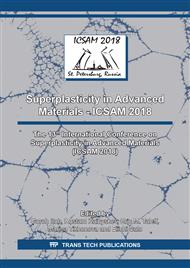[1]
L.H. Qian, Q.H. Lu, W.J. Kong, K.Lu, Electrical resistivity of fully - relaxed grain boundaries in nanocrystalline Cu, Scripta Mater. 50 (2004) 1407-1411.
DOI: 10.1016/j.scriptamat.2004.02.026
Google Scholar
[2]
Y.K. Huang, A.A. Menovsky, F.R. de Boer, Electrical resistivity of nanocrystalline copper, Nanostruct. Mater. 2 (1993) 505-513.
DOI: 10.1016/0965-9773(93)90168-b
Google Scholar
[3]
R. K. Islamgaliev, K. Pekala, M. Pekala, and R. Z. Valiev, The determination of the grain boundary width of ultrafine grained copper and nickel from electrical resistivity measurements, Phys. Status Solidi A. 162, (1997) 559-566.
DOI: 10.1002/1521-396x(199708)162:2<559::aid-pssa559>3.0.co;2-z
Google Scholar
[4]
H. Gleiter, Nanocrystalline materials, Prog. Mater. Sci. 33 (1989) 223-315.
Google Scholar
[5]
X. H. Chen, L. Lu, K. Lu. Electrical resistivity of ultrafine-grained copper with nanoscale growth twins, Journal of applied physics. 102, (2007) 083708.
DOI: 10.1063/1.2799087
Google Scholar
[6]
J.B. Correia, H.A. Davies, C.M. Sellars, Strengthening in rapidly solidified age hardened CuCr and CuCrZr alloys, Acta Mater. 45 (1997) 177 - 190.
DOI: 10.1016/s1359-6454(96)00142-5
Google Scholar
[7]
A. Vinogradov, V. Patlan, Y. Suzuki, K. Kitagawa, V.I. Kopylov, Structure and properties of ultra-fine grain Cu–Cr–Zr alloy produced by equal-channel angular pressing, Acta Mater. 50 (2002) 1639 - 1651.
DOI: 10.1016/s1359-6454(01)00437-2
Google Scholar
[8]
K. Han, R.P. Walsh, A. Ishmaku, V. Toplosky, L. Brandao, J.D. Embury, High strength and high electrical conductivity bulk Cu, Philos. Mag. 84 (2004) 3705-3716.
DOI: 10.1080/14786430412331293496
Google Scholar
[9]
Y. Zhang, Y.S. Li, N.R. Tao, K. Lu, High strength and high electrical conductivity in bulk nanograined Cu embedded with nanoscale twins, Appl. Phys. Lett. 91 (2007) 211901.
DOI: 10.1063/1.2816126
Google Scholar
[10]
L.X. Sun, N.R. Tao, K. Lu. A high strength and high electrical conductivity bulk CuCrZr alloy with nanotwins, Scr. Mater. 99 (2015) 73-76.
DOI: 10.1016/j.scriptamat.2014.11.032
Google Scholar
[11]
D.J. Chakrabarti, D.E. Laughlin, The Cr-Cu (Chromium-Copper) system, Bull. Alloy Phase Diagrams 5 (1984) 59-68.
DOI: 10.1007/bf02868727
Google Scholar
[12]
L. Lu, Y. F. Shen, X.H. Chen, L.H. Qian, and K. Lu, Ultrahigh strength and high electrical conductivity in copper, Science. 304 (2004) 422-426.
DOI: 10.1126/science.1092905
Google Scholar
[13]
P. Liu, B.X. Kang, X.G. Cao, J.L. Huang, H.C. Gu, Strengthening mechanisms in a rapidly solidified and aged Cu-Cr alloy, J. Mater. Sci. 35 (2000) 1691-1694.
Google Scholar
[14]
P.B. Hirsch, F.J. Humphreys, Plastic deformation of two - phase alloys containing small undeformable particles, in: Physics of Strength and Plasticity, Metallurgy, Moscow, 1972, pp.158-186 (in Russian).
Google Scholar
[15]
A.J.E. Foreman, M.I. Maki, Dislocation movement through random arrays of obstacles, Phil. Mag. 14 (9) (1966) Р. 911–924.
DOI: 10.1080/14786436608244762
Google Scholar
[16]
R. Peierls, Tlie size of a dislocation, Proc. Phys. Soc. 52 (1940) 34–37.
Google Scholar
[17]
R. Fleischer, W. Hibbard, Hardening during the formation of a solid solution, in: V.A. Alekseyev (Eds.), Structure and mechanical properties of metals, Metallurgy, Moscow, 1967, pp.85-111 (in Russian).
Google Scholar
[18]
A. Matthiessen, C. Vogt, On the Influence of Temperature on the Electric Conducting-Power of Alloys, Phil. Trans. R. Soc. Lond. 154 (1864) 167-200.
Google Scholar
[19]
A.A. Abrikosov, Fundamentals of the theory of metals, Nauka, Moscow, 1987 (in Russian).
Google Scholar
[20]
W.A. Harrison. Resistivity due to dislocations in copper, J. Phys. Chem. Solids. 5(1958)44 – 46.
Google Scholar
[21]
M. J. Zehetbauer, H. P. Stüwe, A. Vorhauer, E. Schafler, J. Kohout, The role of hydrostatic pressure in severe plastic deformation, Advansed engineering materials. 5 (2003) 330–337.
DOI: 10.1002/adem.200310090
Google Scholar
[22]
A. F. Mayadas, M. Shatzkes, Electrical-resistivity model for polycrystalline films: the case of arbitrary reflection at external surfaces, Phys. Rev. B1 (1970) 1382.
DOI: 10.1103/physrevb.1.1382
Google Scholar
[23]
J. M. E. Harper, J. C. Cabral, P. C. Andricacos, L. Gignac, I. C. Noyan, K. P. Rodbell, C. K. Hu, Mechanisms for microstructure evolution in electroplated copper thin films near room temperature, J. Appl. Phys. 86 (1999) 2516.
DOI: 10.1063/1.371086
Google Scholar
[24]
Dong Yuecheng, I.V. Alexandrov, V.D. Sitdikov, J.T. Wang, The effect of temperature on deformation behavior and evolution of microstructure of Cu in different structure states at dynamic deformation, Letters on materials, 3 (2013).
DOI: 10.22226/2410-3535-2013-2-79-82
Google Scholar
[25]
L. Remy, Kinetics of f.c.c. deformation twinning and its relationship to stress-strain behavior, Acta Metall. 26 (1978) 443–451.
DOI: 10.1016/0001-6160(78)90170-0
Google Scholar
[26]
A. Howie, The electrical resistivity of stacking faults, Philos. Mag. 5 (1960) 251-271.
Google Scholar
[27]
I. Mezokh, V.A. Yanushkevich, L.I. Ivanov, The formation of point defects in Ni under the influence of giant laser pulses, Physics and Chemistry of Material Processing, 4 (1971) 163-165 (in Russian).
Google Scholar


